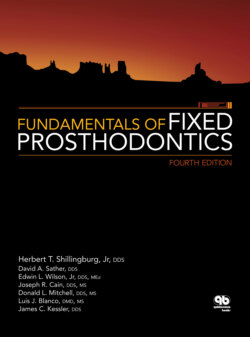Читать книгу Fundamentals of Fixed Prosthodontics - James C. Kessler - Страница 71
Facebow record technique
ОглавлениеThe reference plane indicator is used to measure a point 43 mm above the incisal edges of the maxillary incisors on the right side. This point is marked with a felt-tip marker (Fig 5-40). This will form the anterior, or third, reference point for the facebow transfer.
Two horseshoe wax wafers (Surgident Coprwax Bite Wafer) are heated in warm tap water until they become soft and flexible. A wafer is adapted to each side of the bite fork so that it is uniformly covered. The wax-covered bite fork is placed between the teeth, with the bite fork shaft to the patient’s right. The fork is centered by aligning the index ring on the fork with the patient’s midline. The patient is instructed to bite lightly into the wax to produce shallow indentations of the cusp tips in the wax. The wax is cooled, and the bite fork is removed from the mouth. Any excess wax is trimmed off the bite fork.
The maxillary cast is tried in the wax record to ensure that it will seat without rocking. If the cast fails to seat, the occlusal surfaces of the cast are checked for nodules of stone. If none are evident, there is a distortion in the registration or the cast.
The reference pin is fastened to the underside of the face-bow by tightening the thumbscrew (Fig 5-41). The clamp marked with a 2 should be on the patient’s right (with the left side of the instrument viewed from the front).
Fig 5-42 The dentist places the clamp over the bite fork shaft while the patient inserts the earpieces.
Fig 5-43 The thumbscrew on the front of the facebow is tightened.
Fig 5-44 The reference pointer is aligned with the reference mark.
Fig 5-45 The clamps in the facebow assembly are tightened.
The bite fork is placed in the mouth, and the patient is instructed to hold it securely between the maxillary and mandibular teeth. The patient should grip both arms of the facebow to guide the plastic earpieces into the external auditory meati, in the same manner as one would place a stethoscope into the ears (Fig 5-42). While the patient is inserting the earpieces, the operator should slide the clamp marked with a 2 onto the shaft of the bite fork. The clamp should be positioned above the shaft. The single thumbscrew on the front of the facebow is tightened (Fig 5-43).
The anterior reference pointer is extended while the facebow is moved up or down. When the pointer is properly aligned with the anterior reference point, the thumbscrew is tightened (Fig 5-44). With the facebow still supported, the set screw on clamp 1 is tightened on the vertical reference pin (Fig 5-45). Then clamp 2 is tightened on the horizontal reference pin. For added stability and peace of mind, the patient can continue to support the facebow by holding the side arms. The facebow should not be allowed to torque or tilt during the tightening procedure.
The thumbscrew on the front of the facebow is loosened by a quarter turn. As the patient opens the mouth, the assembly is removed from the head. The clamps are rechecked and tightened. The bite fork assembly is removed from the underside of the facebow by loosening the set screw on the clamp by a quarter turn. Only the bite fork assembly needs to be used for mounting the maxillary cast and should be disinfected at this time. The facebow, after being disinfected with a hospital-grade disinfectant, is ready for use on another patient.
Fig 5-46 The articulator index is placed on the lower member of the articulator.
Fig 5-47 The maxillary cast in the bite fork is positioned by the articulator index.
